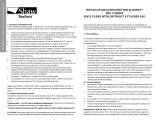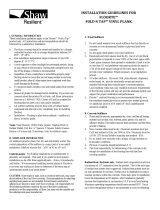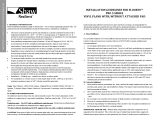Page is loading ...

I. GENERAL INFORMATION
These installation guidelines apply to the VersaLock
®
product only.
All instructions and recommendations should be followed for a
satisfactory installation.
• The oor covering should be stored and installed in a climate controlled
location with an average temperature between 65° - 85°F - 18°-29°C.
• Acclimate material a minimum of 24 to 48 hours prior to installation in
the room/ location where the installation will take place.
• Do not store directly on concrete, allow for air circulation. Do not open
the cartons but spread them out and protect corners from damage.
• Failure to follow these guidelines may result in an installation failure
(i.e. ooring may expand or contract, resulting in gapping). VersaLock
®
Plank is an interior product and must be installed in a temperature-
controlled environment, maintained between 65 and 85 degrees F -
18°-29°C. Please keep in mind a concrete oor can be up to ten degrees
colder than the actual room temperature.
• Avoid exposure to direct sunlight for prolonged periods; such exposure
may result in discoloration, and excessive temperatures can cause the
ooring to expand and lift off of the suboor.During peak sunlight hours,
the use of the drapes or blinds is recommended.
• Regardless of new construction or remodelling projects, keep ooring
stored in rooms that are not being worked in and only install product after
all other trades have completed work that could damage the ooring.
• To minimize shade variation, mix and install planks from several cartons.
• Inspect all planks for damage before installing. If you have any concerns
about the product t or nish, call Shaw Information Services at 1-800-
441-7429. Claims will not be accepted for ooring that has been cut to
size and/or installed.
• All suboor patching must be done with a Portland based compound
and allowed to dry completely prior to installing ooring.
• Installation – This product can be installed on, above, or below grade.
• VersaLock, Shaw’s patented locking technology, is water/moisture
resistant and reliably secures the ooring panels on all four sides.
However, excessive moisture in the suboor could promote mold,
mildew, and other moisture related issues like the trapping of moisture
emissions under the ooring, which may contribute to an unhealthy
indoor environment.
• Shaw Industries does not warrant nor is responsible for damage to oor
covering due to moisture related issues.
Tools: Tape Measure, Utility Knife, Tapping Block, Pull Bar, ¼" Spacers,
T-Square, Safety Glasses, Broom or Vacuum and, if necessary, tools for
suboor repair.
II. SUBFLOOR INFORMATION
All suboors must be clean, at, dry and structurally sound. The correct
preparation of the suboor is a major part of a successful installation.
Roughness or unevenness of the suboor may telegraph through the new
oor covering, resulting in an unsightly surface and may cause excessive
wear on high spots. Suboor must be at – 3/16" in 10' or 1/8" in 6'.
CAUTION: Some types of nails, such as common steel nails, may cause
discoloration of the vinyl oor covering. Recommendations for attaching
underlayment panels are not included. Solvent based construction adhesives are
known to stain vinyl oor coverings. All responsibility for discoloration problems
caused by the use of the above mentioned products is not the responsibility of
Shaw, but rests with the installer and the underlayment panel manufacture.
A. Wood Suboors
1. Do not install material over wood suboors that lay directly on concrete or
over dimensional lumber or plywood used over concrete.
2. Do not apply sheet plastic over wood suboors.
3. Basements and crawl spaces must be dry. Use of a 6 mil black polyethylene
is required to cover 100% of the crawl space earth. Crawl space clearance
from ground to underside of joist is to be no less than 18” and perimeter
vent spacing should be equal to 1.5% of the total square footage of the
crawl space area to provide cross ventilation. Where necessary, local
regulations prevail.
4. All other suboors - Plywood, OSB, particleboard, chipboard, wafer board,
etc. must be structurally sound and must be installed following their
manufacturer’s recommendations. Local building codes may only establish
minimum requirements of the ooring system and may not provide
adequate rigidity and support for proper installation and performance.
5. If the surface of the wood suboor is not smooth, a 1/4" underlayment
panel must be installed over the suboor, per the underlayment
manufacturer’s written instructions.
6. Versalock resilient ooring is not recommended directly over re-retardant
treated plywood or preservative treated plywood. An additional layer of
APA rated 1/4" thick underlayment should be installed.
B. Concrete Suboors
1. New and existing concrete suboors should meet the guidelines of
the latest edition of ASTM F 710, “Standard Practice for Preparing
Concrete Floors to Receive Resilient Flooring” available from the
American Society for Testing and Materials, 100 Barr Harbor Drive, West
Conshohocken, PA 19428; 610-832-9585; http://www.astm.org
2. Floors shall be smooth, permanently dry, clean, and free all foreign material
such as dust, wax, solvents, paint, grease, oils, and old adhesive residue. The
surface must be hard and dense, and free from powder or aking.
3. New concrete slabs must be dry. Maximum moisture level per CaCl test
method is 8 lbs. per 1000 in 24 hr. Maximum level for ASTM 2170 In-situ
Relative humidity test method - 85%.
4. Do no install over concrete with a history of high moisture or
hydrostatic conditions.
5. Maximum acceptable ph level of 9 or less
6. The nal responsibility for determining if the concrete is dry enough for
installation of the ooring lies with the oor covering installer.
7. Holes, grooves, expansion joints and other depressions must be lled
with a Portland based patching and levelling product, and troweled
smooth and feathered even with the surrounding surface.
Radiant Heat: Radiant heat components must have a minimum of 1/2"
separation from the product. This is the only type of radiant heat system that
is approved. Radiant heat system must be on and operational for at least 2
weeks prior to installation to reduce residual moisture within the concrete.
Three days prior to installation lower the temperature to 65 degrees, after
installation gradually increase the temperature in increments of 5° F to avoid
overheating. Maximum operating temperature should never exceed 85°F. Use
of an in-oor temperature sensor is recommended to avoid overheating.
! WARNING! DO NOT SAND, DRY SWEEP, DRY SCRAPE, DRILL,
SAW, BEADBLAST OR MECHANICALLY CHIP OR PULVERIZE EXISTING
RESILIENT FLOORING, BACKING, LINING FELT, ASPHALTIC “CUTBACK”
ADHESIVES OR OTHER ADHESIVES.
These products may contain either asbestos bers and/or crystalline silica.
Avoid creating dust. Inhalation of such dust is a cancer and respiratory
tract hazard. Smoking by individuals exposed to asbestos bers greatly
INSTALLATION GUIDELINES
FOR VERSALOCK
®
VINYL PLANK

increases the risk of serious bodily harm. Unless positively certain that the
product is a non-asbestos-containing material, you must presume it contains
asbestos. Regulations may require that the material be tested to determine
asbestos content and may govern the removal and disposal of material. See
current edition of the Resilient Floor Covering Institute (RFCI) publication
Recommended Work Practices for Removal of Resilient Floor Coverings for
detailed information and instructions on removing all resilient covering
structures. For current information go to www.rfci.com
C. Existing Floor Coverings
• VersaLock ooring can be installed over most existing hard–surface
oor coverings, provided that the existing oor surface is clean, at dry
and structurally sound.
• Quarry tile, terrazzo and ceramic tile - Use caution with highly
embossed tile. This type of tile plus grout joints should be lled with a
high quality cementitious patching product.
• When the removal of the existing resilient oor covering is not an option
then it must be covered with an embossing levelling compound or an
equivalent in order to provide a smooth suboor surface. Otherwise,
telegraphing may occur.
• Existing sheet vinyl oors should not be heavily cushioned and not exceed
more than one layer in thickness. Soft underlayment and soft substrates
will diminish VersaLocks inherent strength in resisting indentations.
• Installation is NOT allowed over any type of carpet.
• Insert the following after Installation is NOT allowed over any type
of carpet.
• Never use solvents or citrus adhesive removers to remove old adhesive
residue. Solvent residue left in and on the suboor may affect the new
oor covering.
III. INSTALLATION
VersaLock plank ooring is designed to be installed
utilizing the oating method only. Never secure the
planks to the suboor. Do not install cabinets or xed
objects on top of the ooring. Proper expansion space
is required. Undercut all doorjambs. Do not fasten
wall mouldings and or transition strips to the planks.
1. Before you start with the installation, it is
important to determine the layout of the
ooring. Proper planning and layout will prevent
having narrow plank widths at wall junctures or
very short length pieces at the end of rows.
2. As with all plank products, install the planks
parallel to the longest exterior wall.
3. Determine if the starter row will need to be cut.
If the rst row of planks does not need to be
trimmed in width, it will be necessary to cut off
the unsupported tongue so that a clean, solid
edge shows towards the wall.
4. Installation of the product must start from the
left side of the room, working to the right when
working in front of the planks or facing the
starting wall.
5. Install the second plank in the row by angling
the end tongue into the end groove of the
rst plank. Be careful not to bend the corner
of the plank. Maintain an expansion gap of
approximately 5/16" - 8mm from the wall. Start
the second row by cutting a plank to the desired
length. Keep in mind that the plank must not
be shorter than 6" (15cm) to achieve the best
appearance.
6. Install the rst plank in the second row by inserting the long side tongue into
the groove of the plank in the rst row. This is best done with a low angle
of the plank. Maintain pressure into the side seam as you rotate the plank
to the suboor. Install the second plank in the second row by inserting the
short end tongue into the previously installed plank groove. Align the plank
so that the long side tongue tip is positioned just over the groove lip of the
plank in the rst row. Working from the end seam, at a low angle, insert the
long tongue into the groove of the adjoining plank. Very little force is required
to seat the tongue into the groove. You should feel the tongue lock into the
groove.
7. Work across the length of the room installing planks along the wall in the
rst row and then aligning the planks in the second row. It is critical to keep
these two rows straight and square, as they are the “foundation” for the rest of
the installation. Check squareness and straightness often.
8. Cut the last plank in the rst row and leave an expansion gap of around 5/16"
- 8mm. Planks may be cut with a utility knife using the “score and snap”
technique. The leftover of this plank may be used to start the third row if it’s a
minimum 6" - 15cm long.
9. Continue installing planks and make sure to achieve a random appearance
with end pieces of minimum 6" - 15cm. Check that all planks are fully
engaged; if a slight gapping is found, the gap can be tapped together by using
a tapping block and a scrap of ooring to cover the tapping block in order to
avoid damages on the planks.
10. When tting under door casings, etc., the exibility and convenient
connection of VersaLock becomes evident. If necessary, a at pull bar may be
used to assist in locking the planks.
11. When tting around obstacles or into irregular spaces, planks can be cut easily
and cleanly using a utility knife with a sharp blade. It is often benecial to
make a cardboard template of the area and transfer this pattern to the plank.
12. Protect all exposed edges of the ooring by installing wall moulding and/or
transition strips. Make sure that no plank will be secured in any way to the
sub oor.
13. Protect the nished ooring from exposure to direct sunlight.
IV. REPAIRS
1. VersaLock plank ooring is tough and durable;
however, if a plank becomes damaged, it can
be replaced. If the damaged plank is along the
perimeter of the room, the easiest technique is to
disconnect the planks until the damaged plank
is removed. Replace the plank and reassemble
the planks. If it is impractical to disconnect and
reassemble the ooring, the following procedure
should be followed:
2. It’s recommended to use painters tape along the
sides of the board to be replaced to prevent damage
to the adjoining boards.
3. Using a Utility Knife, cut through the center of the
damaged plank, running the length of the plank.
4. Carefully remove cut pieces from the insert. You can use a utility knife to
remove the pieces from the oor. Clean up any debris from opening area.
5. To prepare replacement plank. Cut and remove tongue from the long side and
the short end of the plank. This can be accomplished by using a Utility knife.
6. Using a Utility Knife, remove approximately 1.5 inches of the groove on the
long side of the plank from the tongue end.
7. Apply a small bead of Shaw 4062 seam sealer or use a Ethyl Cyanoacrylate
adhesive (super glue) to the groove of the boards in the oor.
8. Insert replacement plank, locking the long side joint (groove side) into the
existing oor. NOTE: The tongue end of the replacement plank will overlap
the existing oor prior to be fully inserted.
9. Using a scrap piece of plank as a tapping device, tap the groove end into
place. Insert the blade of a Utility knife on the opposite side to lift and adjust
the end as it is being tapped into place.
10. Place a weight on the plank until the adhesive sets. (Shaw recommends
minimum 6-8 hours).
© 072214, 5th revision, Shaw Industries Group, Inc., a Berkshire Hathaway Company
1/2


